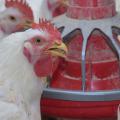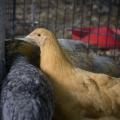Molting of laying hens
Each year chickens molt, or lose the older feathers, and grow new ones. Most hens stop producing eggs until after the molt is completed. The rate of lay for some hens may not be affected, but their molting time is longer. Hens referred to as "late molters" will lay for 12 to 14 months before molting, while others, referred to as "early molters," may begin to molt after only a few months in production. Late molters are generally the better laying hens and will have a more ragged and tattered covering of feathers. The early molters are generally poorer layers and have a smoother, better-groomed appearance.
Early molters drop only a few feathers at a time and may take as long as 4 to 6 months to complete the molt. Early molters are usually poor producers in a flock. Late molting hens will produce longer before molting and will shed the feathers quicker (2 to 3 months). The advantage of late molters is that the loss of feathers and their replacement takes place at the same time. This enables the hen to return to full production sooner.
The order in which birds lose their feathers is fairly definite. The feathers are lost from the head first, followed in order by those on the neck, breast, body, wings, and tail. A definite order of molting is also seen within each molting section, such as the loss of primary flight feathers before secondary flight feathers on the wings.
The primary wing feathers determine whether a hen is an early or late molter. These large, stiff flight feathers are observed on the outer part of each wing when the wing is spread. Usually 10 primary feathers on each wing are separated from the smaller secondary feathers by a short axial feather.
Molting birds lose the primary feathers in regular order, beginning with the feather nearest the axial feather and progressing to the outer wing-tip feathers. Late molting hens will lose primary feathers in groups of two or more feathers, whereas early molters lose feathers individually. Replacement feathers begin to grow shortly after the old feathers are shed. Late molting birds can be distinguished by groups of replacement feathers showing similar stages of growth.
Publications
News
STARKVILLE, Miss. -- Until an avian flu vaccine for chickens or other alternative is federally approved, commercial poultry operations in the U.S.
STARKVILLE, Miss. -- If egg prices have seemed higher than ever lately, it’s because they are, and consumers can place much of the blame squarely at the feet of the ongoing bird flu outbreak.
With highly pathogenic avian influenza, or HPAI, in the environment in Mississippi, owners of backyard flocks have to take extra steps to keep their chickens healthy.
Avian influenza poses an extremely low risk to human health and none to food safety in Mississippi, but its presence poses a risk to backyard flocks and the state’s $3 billion commercial poultry industry.






